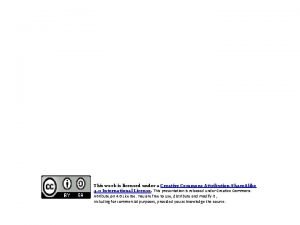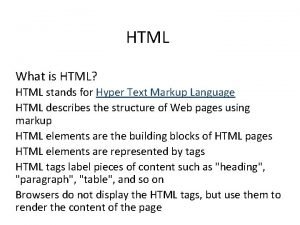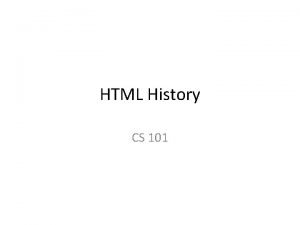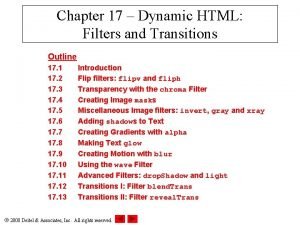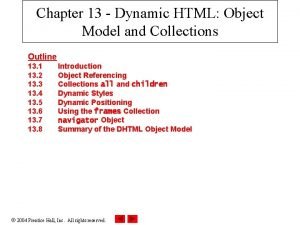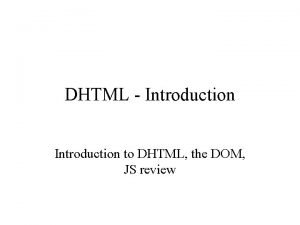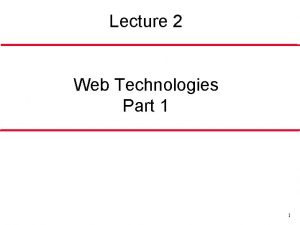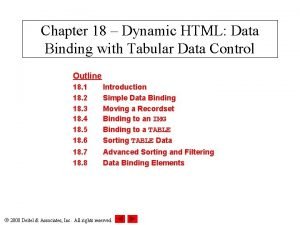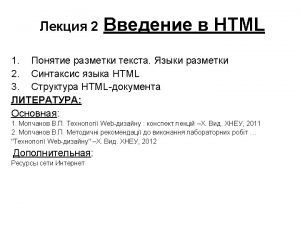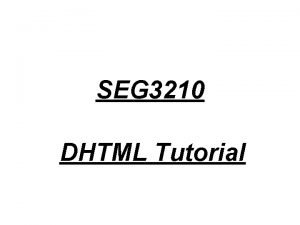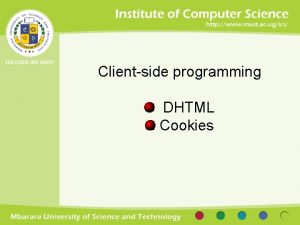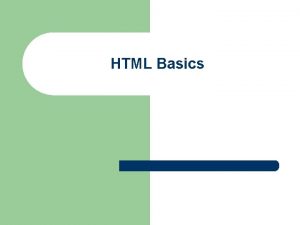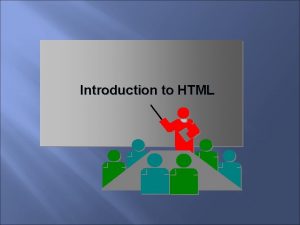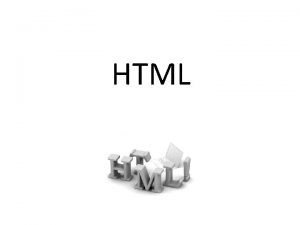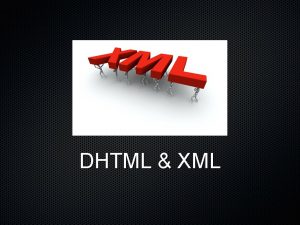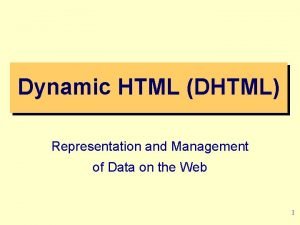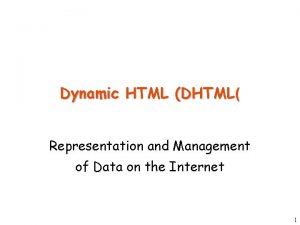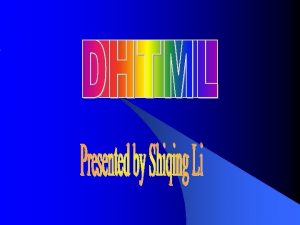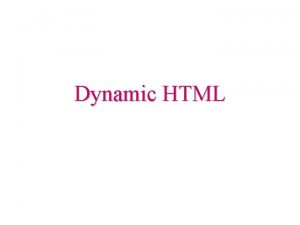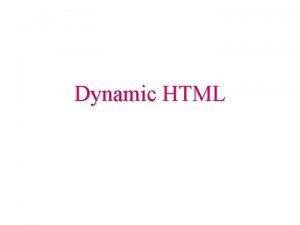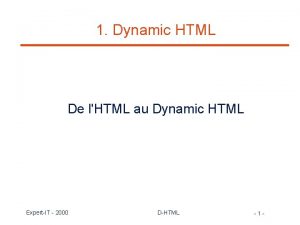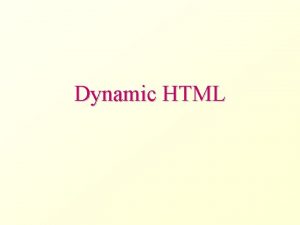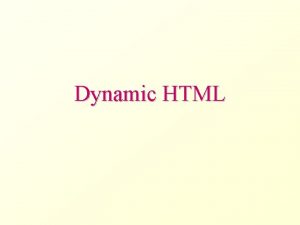DHTML DHTML DHTML stands for Dynamic HTML HTML



































- Slides: 35

DHTML

DHTML • DHTML stands for Dynamic HTML – HTML supports Java. Script – HTML supports the Document Object Model (DOM) – HTML supports HTML Events – HTML supports Cascading Style Sheets (CSS) • DHTML is about using these features, to create dynamic and interactive web pages.

DHTML • DHTML is the art of combining HTML, Java. Script, DOM, and CSS – Java. Script is the most popular scripting language on the internet, and it works in all major browsers. • DHTML is about using Java. Script to control, access and manipulate HTML elements. – The HTML DOM(Document Object Model) defines a standard way for accessing and manipulating HTML documents. • DHTML is about using the DOM to access and manipulate HTML elements. – HTML Events are a part of the HTML DOM. • DHTML is about creating web pages that reacts to (user)events. – CSS defines how to display HTML elements. • DHTML is about using Java. Script and the HTML DOM to change the style and positioning of HTML elements.

Javascript • Java. Script can create dynamic HTML content. – You can place any number of scripts in an HTML document. – Scripts can be placed in the <body>, or in the <head> section of an HTML page, or in both. • Java. Script can be placed in the <body> and the <head> sections of an HTML page. • Scripts can also be placed in external files. – External scripts are practical when the same code is used in many different web pages. • In Java. Script, the statement: document. write(), is used to write output to a web page.

Script tag • In HTML, Java. Script code must be inserted between <script> and </script> tags. • <html> <body> <script type="text/javascript"> document. write(Date()); </script> </body> </html>

Javascript in <head> <html><head> <script> function my. Function() { document. get. Element. By. Id("demo"). inner. HTML = "Paragraph changed. "; } </script> </head> <body> <h 1>My Web Page</h 1> <p id="demo">A Paragraph</p> <button type="button" onclick="my. Function()">Try it</button> </body> </html>

Javascript in <body> • <html> <body> <h 1>My Web Page</h 1> <p id="demo">A Paragraph</p> <button type="button" onclick="my. Function()">Try it</button> <script> function my. Function() { document. get. Element. By. Id("demo"). inner. HTML = "Paragraph changed. "; } </script> </body> </html>

External Javascript • <html> <body> <script src="my. Script. js"></script> </body> </html> • my. Script. js <script> document. get. Element. By. Id("demo"). inner. HTML = "My First Java. Script"; </script>

Variables • Java. Script allows you to declare and use variables to store values. • How to assign a name to a variable? – – – – Include uppercase and lowercase letters Digits from 0 through 9 The underscore _ and the dollar sign $ No space and punctuation characters First character must be alphabetic letter or underscore Case-sensitive No reserved words or keywords

Which one is legal? My_variable $my_variable 1 my_example _my_variable @my_variable My_variable_example ++my_variable %my_variable #my_variable ~my_variable my. Variable. Example Legal Illegal

Data Types • Java. Script allows the same variable to contain different types of data values. • Primitive data types – Number: integer & floating-point numbers – Boolean: logical values “true” or “false” – String: a sequence of alphanumeric characters • Composite data types (or Complex data types) – Object: a named collection of data – Array: a sequence of values

Javascript Objects • • Window Document Form History Navigator Image Array etc….

Window object • Methods – Alert – Prompt – Confirm

Using the alert() Method <head> <script language=“Java. Script”> alert(“An alert triggered by Java. Script”); </script> </head> • It is the easiest methods to use amongst alert(), prompt() and confirm(). • You can use it to display textual information to the user (simple and concise). • The user can simply click “OK” to close it.

Using the confirm() Method <head> <script language=“Java. Script”> confirm(“Are you happy with the class? ”); </script> </head> • This box is used to give the user a choice either OK or Cancel. • It is very similar to the “alert()” method. • You can also put your message in the method.

Using the prompt() Method <head> <script language=“Java. Script”> prompt(“What is your student id number? ”); prompt(“What is your name? ”, ”No name”); </script> </head> • This is the only one that allows the user to type in his own response to the specific question. • You can give a default value to avoid displaying “undefined”.

Three methods <script language="Java. Script"> alert("This is an Alert method"); confirm("Are you OK? "); prompt("What is your name? "); prompt("How old are you? ", "20"); </script>

Variable on-the-fly <head> <script language=“Java. Script”> Variable declaration var id; id = prompt(“What is your student id number? ”); alert(id); name = prompt(“What is your name? ”, ”No name”); alert(name); </script> </head> • We should use “var” because it is more easy to keep track of the variables.

Javascript Functions alert is the name of a predefined function in the Java. Script language alert("Hello World!"); this statement is is known as a function call this is a string we are passing as an argument (parameter) to the alert function 19

General Function Definition Syntax function Function. Name ( parameter 1, . . . , parametern ) { variable declaration(s) statement(s) } • If there are no parameters, there should be nothing inside of the ()'s function Function. Name() {. . . } • There may be no variable declarations. 20

Function parameters • Parameter: – Variable used within a function • Placing a parameter name within the parentheses of a function definition is the same as declaring a new variable • Functions do not have to contain parameters – In this case use empty parentheses

Keyword function User-defined function name 0 or more parameters Opening and closing brackets

Sample Function <head> <title>Function Example</title> Function <script type="text/javascript"> Definition function Print. Message() { alert("A message for you: nn. Have a nice day!"); } </script> </head> <body> <script type="text/javascript"> Print. Message(); </script> </body> Function Call 23

Screenshot of Function Example 24

DOM(Document Object Model) • The HTML DOM is a standard object model and programming interface for HTML. • It defines: – The HTML elements as objects – The properties of all HTML elements – The methods to access all HTML elements – The events for all HTML elements • In other words: – The HTML DOM is a standard for how to get, change, add, or delete HTML elements.

WHY DOM? • Document Object Model – Your web browser builds a model of the web page (the document) that includes all the objects in the page (tags, text, etc) – All of the properties, methods, and events available to the web developer for manipulating and creating web pages are organized into objects – Those objects are accessible via scripting languages in modern web browsers

This is what the browser reads <html> <head> <title>Sample DOM Document</title> </head> <body> <h 1>An HTML Document</h 1> <p>This is a <i>simple</i> document. </body> </html> This is what the browser displays on screen.

Document This is a drawing of the model that the browser is working with for the page. <html> <head> <body> <title> "Sample DOM Document" <h 1> <p> "An HTML Document" "This is a" <i> "simple" "document"

DOM • The HTML DOM can be accessed with Java. Script (and with other programming languages). • In the DOM, all HTML elements are defined as objects. • The programming interface is the properties and methods of each object. – A property is a value that you can get or set (like changing the content of an HTML element). – A method is an action you can do (like add or deleting an HTML element).

Why is this useful? • Because we can access the model too! – the model is made available to scripts running in the browser, not just the browser itself • A script can find things out about the state of the page • A script can change things in response to events, including user requests

Example-Change an element • The following example changes the content of an h 1 element: • <html> <body> <h 1 id="header">Old Header</h 1> <script type="text/javascript"> document. get. Element. By. Id("header"). inner. HTML ="New Header"; </script> </body> </html> • In the example above, get. Element. By. Id is a method, while inner. HTML is a property.

Change an attribute • The following example changes the src attibute of an img element: • <html> <body> <img id="image" src="smiley. gif"> <script type="text/javascript"> • document. get. Element. By. Id("image"). src="landscape. jpg"; </script> </body> </html>

Finding HTML Elements • document. get. Element. By. Id( ) -Find an element by element id – var my. Element = document. get. Element. By. Id(“main"); • document. get. Elements. By. Tag. Name() -Find elements by tag name – var x = document. get. Elements. By. Tag. Name("p"); • document. get. Elements. By. Class. Name() -Find elements by class name – var x = document. get. Elements. By. Class. Name("intro");

Changing HTML Elements • element. inner. HTML=Change the inner HTML of an element • element. attribute=Change the attribute of an HTML element • element. set. Attribute(attribute, value)=Change the attribute of an HTML element • element. style. property=Change the style of an HTML element

DEMO on Objects
 Dhtml stands for
Dhtml stands for What is html stands for? *
What is html stands for? * Html stands
Html stands Vertical blinds
Vertical blinds Dhtml form
Dhtml form The html
The html Nn webklient
Nn webklient Dhtml introduction
Dhtml introduction Dhtml
Dhtml Is dhtml new language explain shortly
Is dhtml new language explain shortly Transferered
Transferered Dynamic html data binding
Dynamic html data binding Doctype html html head
Doctype html html head Slidetodoc.com
Slidetodoc.com Doctype html html head
Doctype html html head Canvas доска
Canvas доска код страницы html
код страницы html Tack för att ni har lyssnat
Tack för att ni har lyssnat Treserva lathund
Treserva lathund Läkarutlåtande för livränta
Läkarutlåtande för livränta Påbyggnader för flakfordon
Påbyggnader för flakfordon Tack för att ni lyssnade
Tack för att ni lyssnade Att skriva debattartikel
Att skriva debattartikel Egg för emanuel
Egg för emanuel En lathund för arbete med kontinuitetshantering
En lathund för arbete med kontinuitetshantering Tack för att ni har lyssnat
Tack för att ni har lyssnat Rutin för avvikelsehantering
Rutin för avvikelsehantering Var finns arvsanlagen
Var finns arvsanlagen Verifikationsplan
Verifikationsplan Myndigheten för delaktighet
Myndigheten för delaktighet Presentera för publik crossboss
Presentera för publik crossboss Rbk mätning
Rbk mätning Kung dog 1611
Kung dog 1611 Densitet vatten
Densitet vatten Tobinskatten för och nackdelar
Tobinskatten för och nackdelar Nationell inriktning för artificiell intelligens
Nationell inriktning för artificiell intelligens
